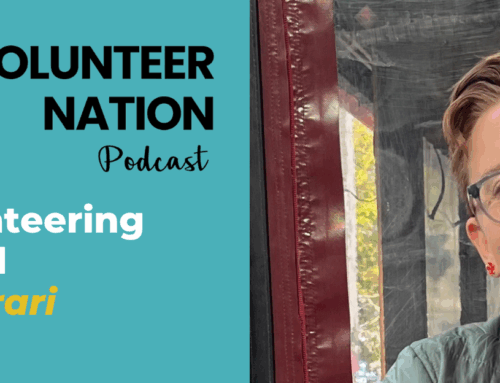
On Modeling Powerful Resilience for Yourself and in Leading Volunteers
When leading volunteers, among the many skills you’ll find helpful, a good measure of resilience is important. We know, as leaders in this world, that we need to be there for other people. One thing we should recognize is that we also need to be there for ourselves. Having resilience is one way we can do that.
Back in November, we hosted a We Rise Together Challenge, and we asked participants, “What do you think it means to be resilient?”
These are some of the responses they offered:
- flexible
- being able to bounce back
- able to deal with change
- facing the challenges and losses
- spring back with a renewed mindset and achieve your goal
- not letting the hard things get you down
- being able to adapt
- to continue in the face of obstacles.
They are all great ideas about what it is to be resilient.
However you define it, we all need to recover from setbacks that invariably come to pass. Fluctuating energy levels, a run of bad luck, or even an occasional ill-advised action are just part of the cycle of life. Severe lows can bring you to a point where your work and capacity for joy are impacted. Feeling stress or overwhelm may also reduce your ability to connect and engage with others.
As leaders, we’ve then got to stop and see if there’s something in our approach we need to change.
Choose to Be Resilient
An interesting thing about resilience is that most of it is chosen. Bouncing back is something we can choose to do; it is a decision we can make. We can make the decision to be persistent.
After a trying 2020, and some tough obstacles already in 2021, even if you’re feeling the most tired you’ve ever felt, you can change things. Being resilient isn’t something that’s inherently part of who we are. It’s actually something we learn how to do. Even if you’re feeling really, really tired and burnt out right now, you can take steps to become more resilient.
Note that there is a lot in the world of resilience that you have control over. That’s the good news. People aren’t just born more or less resilient than others. In fact, there are many people who would argue that the more difficult your life has been, the more resilient you become, because you’ve had to employ that skill set over and over again.
Read on, as we share a story and steps you can take to develop resilience that will serve you in coping with everyday setbacks, as well as when you’re leading volunteers.
Lessons from Zozobra
In Santa Fe, New Mexico, there is a festival that has taken place every year since 1924. It is the annual Burning of Will Shuster’s Zozobra.
Zozobra is a giant marionette. Its name is “the gloomy one” in Spanish. It’s a monster, recreated every year, to represent anything that’s held an individual back over the past year. Interestingly, Zozobra has increased in size over the decades and, these days, stands at about 50 feet tall!
For the festival, people write down things that they want to leave behind for the coming year. Traditionally, the paper and other material they write on is used to craft and stuff Zozobra. So, it is, symbolically, made up of anything that has brought someone down, frustrated, or disappointed them.
Residents and guests of Santa Fe host a party and ‘invite’ Zozobra down to the city park. Now, representing all kinds of obstacles and challenges and gloom, big Z has a big ego. The townspeople say, “Zozobra, look, this party is being held in your honor. So come on down!”. Zozobra accepts the invitation, recognizing it as his best opportunity to invade the heart of the town, destroying all hope and happiness and robbing the city of its most prized possession. And that most prized possession is hope.
So, that’s Zozobra’s whole focus; to blow out all sense of hope for people. As the story goes, he comes down and the city folk start to chant together, “Burn him! Burn him! Burn him!” and they invite the fire spirit. The fire spirit represents hope. It’s the collective hopes, dreams, and faith of the citizens of Santa Fe. The fire spirit comes up and lights Zozobra on fire. And the crowds dance joyfully as happiness and hope are returned to the city.
It is a ritual of letting go. A lot of cathartic energy comes out in writing down what is holding you back and then burning it to ashes.
There are a number of lessons we can take away from the Zozobra story.
Know Your Stories
Research shows that we think 95% of the same thoughts every day. Our brains are on a constant loop and a lot of it is unconscious thought.
Usually, we don’t even know the stories that we’re telling ourselves. We don’t know because we don’t pay attention, let alone analyze them. For a lot of people, there is that inner critic in charge of the stories. Often, that voice is on repeat, telling you that ‘you can’t’.
This can be like trying to win a marathon while carrying your luggage! If we’re carrying something heavy around all the time, we can’t move forward as quickly as we’d like. We won’t have the agility needed for everyday life, let alone leading volunteers.
It’s important to believe, regardless of the challenge, that you have the ability to overcome it. Get that voice to say, “You can!”. Because you absolutely can.
Work can be done to replace limiting beliefs with enabling beliefs.
To start, try watching your mind a little bit. Yes, I’m recommending that you try 15 minutes, even 10 minutes of meditation a day. Now, this is not doing affirmations, where you’re telling yourself something positive, or you have a mantra that you’re intoning over and over. That’s not meditation. Meditation is gaining an awareness of what’s going on in your mind.
Recognize Your Thought Patterns
The goal of meditation is for you to watch your mind at work; to see if your mind is thinking the same thoughts 95% of the time throughout the day. Maybe you’re thinking exactly the same thoughts as you did yesterday. Aim here to just understand what those thoughts are. Some of those thoughts may be sabotaging your success and your resilience, because you may have belief sets and patterns that are not allowing you to move forward.
When you’re paying attention to your mind, it can help release baseline anxiety. Benefits are most potent when it’s practiced regularly. And it does have a huge impact on the ability to moderate stress levels.
One of the other benefits is you will become a more self-reflective person and, thus, a better leader. So, there are a lot of benefits to the practice of meditation when leading volunteers. Don’t think you have to be perfect. Every time you redirect your thoughts back to watching what you’re thinking and watching your mind at work, that is the practice of mindfulness. Whenever you can do that, congratulate yourself.
Here is a list of guided meditations that might be helpful in getting started:
- A Pause for Presence - (Tara Brauch, Mindfulness App) - https://themindfulnessapp.com/
- Nothing Here But You (Mooji, Insight Timer) - https://insighttimer.com
- Releasing Coronavirus Anxiety (Giovanni Dienstmann, Mindfulness App) - https://themindfulnessapp.com/
- Autumn Meditation (Catherine Polan Orzech, Mindfulness App) - https://themindfulnessapp.com/
- Yoga Nidra For Sleep (Jennifer Piercy, Insight Timer) - https://insighttimer.com
- Wellbeing At Work: October Challenge (Jack Kornfield & Tara Brauch, Insight Timer) - https://insighttimer.com
Letting Go
In the Zozobra ritual, they stuff the puppet with and put boxes of what people want to leave behind at its feet and light it all on fire. Maybe you can formulate a similar – hopefully less destructive – method to ridding your mind of obstacles.
Periodically, take stock of the things that disappointed you in the past year: the sorrows; unresolved conflict; perhaps shame for doing something; whatever feeling that is not allowing you to move forward. Sometimes it’s inside your control. Sometimes it’s things that other people have done to you. Sometimes it’s just the circumstance you find yourself in. Your brain space is being taken up by things that can’t be resolved because they’re in the past.
You have things that are in your way, are barriers to your success, beliefs you’ve held that aren’t serving you. Write that all down and then let it go. If it helps, go outside somewhere and burn it. Fold it up and toss it out. Just – safely! – let it go and say goodbye.
Mark the transition between what happened before and where you’re headed in the future. In doing so, you free up the mental and emotional space for behaving mindfully in the present. This is resilience.
Separate the Circumstance from Your Feelings
In mindfulness work, some of the gurus and teachers will say, “YOU aren’t anxious.” You’re not; you’re feeling anxious. When we say “I am anxious”, we identify so closely with what we’re feeling and what our emotions are. “I am anxious.” “I am burnt out.” But in reality, it’s not who you are. It’s something that’s visiting you for the time being. So, it might be better to say “I have anxiety”, or “I have fatigue”.
You’re not fatigued. You have fatigue and sooner or later it’s going to go away. Think about the impermanence of the challenge you’re facing. As a leader, you can be that person that’s leading with equanimity, who has perspective, that person who can be centered and can modulate how they’re responding to what’s happening. In leading volunteers, this skill is invaluable! Believe that if you learn how to do it, you will reduce your anxiety and your feeling of fatigue.
If you haven’t yet seen our free 20 Top Tips from Leaders of Volunteers: How to Survive and Thrive During Times of Crisis, it’s an e-book that was put together with members of our community who, just like you, are leading volunteers and are in touch with very similar challenges to yours. Learn what other people in the industry are recommending for how to thrive despite obstacles. Also, you should check out this recent blog post on banishing burnout.
Control What You Can
Sometimes it feels like there’s so much buffeting us from outside. We recently conducted a poll of our Facebook Insiders Group and it showed that a majority of them feel like a bit like a plastic bag being blown about in the wind. Part of the feeling of burnout is a feeling of lack of control over your environment. While that may be the case, know that you have total control over your responses to the chaos around you.
There are big issues in society that individuals can’t control completely. However, if we engage with others, there is a lot we can work toward. We can certainly get involved in organizations and work for better equity, for example. There are things that we can do as individuals, but we cannot control other people. If we’re living mindfully, we can control the one thing that is it is possible to control, and that is ourselves.
It’s not easy, each effort won’t be perfect but, with practice, you will feel an improvement in your mindset around stressors.
Take Action Toward More Resilience
Whether you’re under stress or just striving for that next goal, change doesn’t happen just because we wish it would. We have to take some action.
Once you’ve reflected on a situation a bit, you need to take the next step – whatever it is. You can change the circumstance as well as how you’re feeling by taking some action. In doing so, you prove to yourself that you can do something about the stressor and create a kind of muscle memory for times of stress. That is resilience.
Find your own personal Zozobra ceremony. Just unburden yourself of things that you should not be worrying about anymore. Say goodbye to any doom and gloom that may be dragging you down and welcome the fire spirit of hope for 2021!
Then set aside some time each day to begin or expand your meditation practice. Remember, it’s just figuring out what your mind is doing. This can help you to recognize your thought patterns and separate what you’re feeling from the circumstance. All of that will help you to act on what you can and let go of that which you cannot control.
Start looking towards the future because there is brightness ahead. You will be the better for it, and more resilient in leading volunteers.
Strengthen Your Volunteer Community
Key to leading volunteers is keeping folks engaged.
Enjoying deep engagement and commitment isn’t magic! It takes a smart strategy.
VolunteerPro has a FREE mini-course, The Art & Science of Volunteer Accountability that explains what it takes to be an “architect of experience” and realize success for your volunteer team. In this short lesson, we share how to harness the science of trust for better supervision and deepen connections with volunteers through purposeful strategy.










Leave A Comment